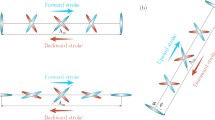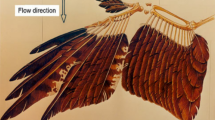Abstract
Rotors with active flap control have considerable potential in reducing vibration and noise and improving aerodynamic performance. However, due to the movement of the flap, there are unavoidable gaps between the components that will lead to significant changes in the aerodynamic characteristics. Moreover, considering the difficulties in motion modeling and the accuracy of the simulation of the flow field in such a narrow gap, carrying out related research is challenging; thus, there has been inadequate targeted research, and that which does exist requires supplementation. To carry out this challenging flow field simulation, the overset assembly algorithm proposed by the author in previous research is adopted in the present study. It is used to successfully assemble the narrow gap, and the accuracy of the simulation is fully verified by comparing the results with the actual experimental results and a grid study. Furthermore, to compensate for the lack of research and experiments on the gap effect, cases considering a complete range of gap widths from an absence of a gap to a width of 10% of the chord length are set up and carried out under the following three case groups: steady cases with a fixed trailing-edge deflection angle, unsteady cases in which only the trailing-edge flap is flapping, and full-motion cases characterized by the periodic flap of the main airfoil and the trailing-edge flap. The results show that the gap increases the drag of the trailing-edge flap and decreases aerodynamic efficiency, especially at low speeds and high angles of attack. Nevertheless, when the gap is unavoidable, there is a range of the gap width that makes unapparent the decrease of aerodynamic efficiency. Moreover, the decrease of aerodynamic efficiency can be reduced as much as possible by a well-designed gap region geometry to ensure that the airfoil and the trailing-edge flap fit together when moving.






























Similar content being viewed by others
References
Friedmann PP, Millott TA (1995) Vibration reduction in rotorcraft using active control—a comparison of various approaches. J Guidance, Control, Dynamics 18(4):664–673. https://doi.org/10.2514/3.21445
Roth D, Enenkl B, Dieterich O (2006) Active rotor control by flaps for vibration reduction—full scale demonstrator and first flight test results. Paper presented at the 32nd European Rotorcraft Forum, Maastricht, The Netherlands, 2006
Straub FK, Kennedy DK, Domzalski DB, Hassan AA, Ngo H, Anand V, Birchette T (2016) Smart material-actuated rotor technology—SMART. J Intell Mater Syst Struct 15(4):249–260. https://doi.org/10.1177/1045389x04042795
Straub FK, Anand VR, Birchette TS, Lau BH (2009) SMART rotor development and wind tunnel test. Paper presented at the 35th European Rotorcraft Forum, Hamburg, 2009
Gerontakos P, Lee T (2008) PIV study of flow around unsteady airfoil with dynamic trailing-edge flap deflection. Exp Fluids 45(6):955–972. https://doi.org/10.1007/s00348-008-0514-4
Birch D, Lee T (2005) Effect of trailing-edge flap on a tip vortex. J Aircraft 42(2):442–447. https://doi.org/10.2514/1.6749
Hassan AA, Straub FK, Noonan KW (2000) Experimental/numerical evaluation of integral trailing edge flaps for helicopter rotor applications. Paper presented at the the 56th Annual Forum of the American Helicopter Society, Virginia Beach, 2000
Kamliya Jawahar H, Ai Q, Azarpeyvand M (2017) Experimental and numerical investigation of aerodynamic performance of airfoils fitted with morphing trailing-edges. Paper presented at the 23rd AIAA/CEAS Aeroacoustics Conference
Feszty D, Gillies EA, Vezza M (2004) Alleviation of airfoil dynamic stall moments via trailing-edge flap flow control. AIAA J 42(1):17–25. https://doi.org/10.2514/1.853
Milgram JH (1997) A comprehensive aeroelastic analysis of helicopter main rotors with trailing edge flaps for vibration reduction. University of Maryland
Aoyama T, Yang C, Kondo N, Saito S (2006) Comparison of noise reduction effect between AFC and conventional IBC by moving overlapped grid method. Paper presented at the 12th AIAA/CEAS Aeroacoustics Conference (27th AIAA Aeroacoustics Conference)
Aoyama T, Yang C, Saito S (2005) Numerical analysis of active flap for noise reduction using moving overlapped grid method. Paper presented at the the American Helicopter Society 61st Forum, Grapevine, 2005
Nakao M, Saito S (2004) Research for The BVI noise reduction using the blade active control. Paper presented at the 30th European Rotorcraft Forum, Marseille, 2004
Shen J, Chopra I (2004) Swashplateless helicopter rotor with trailing-edge flaps. J Aircraft 41(2):208–214. https://doi.org/10.2514/1.9279
Liggett N, Smith MJ (2013) The physics of modeling unsteady flaps with gaps. J Fluids Struct 38:255–272. https://doi.org/10.1016/j.jfluidstructs.2012.12.010
Krzysiak A, Narkiewicz J (2006) Aerodynamic loads on airfoil with trailing-edge flap pitching with different frequencies. J Aircraft 43(2):407–418. https://doi.org/10.2514/1.15597
Gagliardi, Adriano, Barakos GN (2006) Improving hover performance of low-twist rotors using trailing-edge flaps—a computational study. Paper presented at the 32nd European Rotorcraft Forum, Maastricht, 2006
Liu L, Padthe AK, Friedmann PP, Quon E, Smith MJ (2009) Unsteady aerodynamics of flapped airfoils and rotors using CFD and approximate methods. Paper presented at the the American Helicopter Society 65th Annual Forum, Grapevine, 2009
Liu L, Padthe AK, Friedmann PP, Quon E, Smith MJ (2011) Unsteady aerodynamics of an airfoil/flap combination on a helicopter rotor using computational fluid dynamics and approximate methods. J Am Helicopter Soc 56(3):1–13. https://doi.org/10.4050/jahs.56.032003
Jose A, Baeder J (2009) Steady and unsteady aerodynamic modeling of trailing edge flaps with overhang and gap using CFD and lower order models. Paper presented at the 47th AIAA Aerospace Sciences Meeting including The New Horizons Forum and Aerospace Exposition
Jain R, Yeo H, Chopra I (2012) Investigation of trailing-edge flap gap effects on rotor performance using CFD-CSD coupling. Paper presented at the 50th AIAA Aerospace Sciences Meeting including the New Horizons Forum and Aerospace Exposition
Jain R, Yeo H, Chopra I (2013) Investigation of trailing-edge flap gap effects on rotor performance using high-fidelity analysis. J Aircraft 50(1):140–151. https://doi.org/10.2514/1.C031837
Potsdam M, Fulton MV, Dimanlig A (2010) Multidisciplinary CFD/CSD analysis of the smart active flap rotor. Paper presented at the the American Helicopter Society 66th Annual Forum, Phoenix, 2010
Zhu WJ, Behrens T, Shen WZ, Sørensen JN (2013) Hybrid immersed boundary method for airfoils with a trailing-edge flap. AIAA J 51(1):30–41. https://doi.org/10.2514/1.J051446
Hu Z, Xu G, Shi Y (2020) A robust overset assembly method for multiple overlapping bodies. Int J Numer Meth Fluids. https://doi.org/10.1002/fld.4903
Pascioni KA, Cattafesta LN (2014) An experimental investigation of the 30P30N multi-element high-lift airfoil. Paper presented at the 20th AIAA/CEAS Aeroacoustics Conference (35th AIAA Aeroacoustics Conference), Atlanta, Georgia, 2014
Spaid FW (2000) High reynolds number, multielement airfoil flowfield measurements. J Aircraft 37(3):499–507. https://doi.org/10.2514/2.2626
Landon RH (1982) NACA 0012 oscillatory and transient pitching. AGARD R-702
Acknowledgements
A Project Funded by the Priority Academic Program Development of Jiangsu Higher Education Institutions (PAPD).
Author information
Authors and Affiliations
Corresponding author
Additional information
Publisher's Note
Springer Nature remains neutral with regard to jurisdictional claims in published maps and institutional affiliations.
Rights and permissions
About this article
Cite this article
Hu, Z., Xu, G. & Shi, Y. A New Study on the Gap Effect of an Airfoil with Active Flap Control Based on the Overset Grid Method. Int. J. Aeronaut. Space Sci. 22, 779–801 (2021). https://doi.org/10.1007/s42405-021-00364-0
Received:
Revised:
Accepted:
Published:
Issue Date:
DOI: https://doi.org/10.1007/s42405-021-00364-0




